Happy New Year !
In 2013, Japan’s long-awaited resurgence is likely to begin. The birth of the Abe administration should not be viewed cynically as the result of negative public opinion concerning the failure of rule by the Democratic Party of Japan. We should instead regard the election result as a new choice for the path that Japan is going to take after the early 2010s. The significance of the Senkaku Islands problem is on a par with the arrival in Japan of Commodore Perry in the 1850s. Both incidents determined future events in Japan by enabling the country to head in a single direction backed by a unified public opinion.
When Commodore Perry’s fleet arrived in Japan, it demonstrated an enormous technological and economic gap between Japan and the Western world. Japan clearly had two options: be put in a colonial-like servile position or use economic development to become self-reliant. Public opinion caused Japan to open its markets to the world, become an economic and military power, and overcome enormous challenges to accomplish its goals. Likewise, the Senkaku Islands problem gives Japan two options: partnership with China (subservience) or the Japan-U.S. alliance. Japan, which is highly advanced in terms of its democratic polity and capitalist economy, does not have the option of becoming subservient to China, an autocratic communist country. The only choice is to use the Japan-U.S. alliance as the foundation for growing a sense of nationhood, increasing its military strength and driving economic growth. Since the start of the “1955 System,” where the Liberal Democratic Party was Japan’s dominant party, Japan has been struggling with the theological debate of whether to oppose or support communism and whether to oppose the U.S. or be its ally. But the Senkaku Islands problem has made the decision clear. Now the focus of this debate has shifted to a tactical discussion to determine how the Japan-U.S. alliance can be used to contain China as much as possible. The question of whether or not a party has a solution for this strategic issue produced enormous differences in the performances of political parties in this month’s election.
These changes are not limited to politics and geopolitics. Current events will probably bring about profound changes in Japan’s economy and markets. The Democratic Party of Japan took a stance of accommodating China and enacting policies that were anti-business and anti-growth. Now Japan has shifted to the Abe administration of the Liberal Democratic Party, which is committed to the Japan-U.S. alliance and is pro-business and pro-growth. This is an event of historic proportions that may very well signify the true end of the 1955 System along with the end of the 22-year period of deflation and falling stock prices against the backdrop of a strong yen. We are probably witnessing the death of anti-growth pessimism that took hold in Japan after the collapse of Lehman Brothers.
(1) Geopolitical forces were behind the rise and fall of modern-day Japan
Japan’s highs and lows were driven by the Meiji Restoration and Japan-U.S. alliance
For a particular length of time, a country’s economy fluctuates and grows in accordance with economic theory. But from a long-term perspective, politics alone is what determines when an economy will move up and down. And these political forces are determined by national strategies that prioritize security. Looking back at the history of Japan since the Meiji Era provides ample evidence. Between 1867 and the end of the 1930s, a period of about 60 years, Japan enjoyed a remarkable period of growth on a scale rarely seen in the history of the world. The reason was obviously the establishment of a modern nation following the Meiji Restoration. Next, the economy was destroyed by World War II between the late 1930s and late 1940s with modern-day Japan’s defeat in the war . Following the war, Japan staged a miraculous comeback during the four decades between 1950 and 1990. Fueling this remarkable growth was the support provided by the Japan-U.S. security agreement. The Korean War in the early 1950s created an excellent opportunity for Japan to expand its economy. Once this growth began, it did not end until the asset bubble burst.
Figure 1: The Rise and Fall of Modern-day Japan and Geopolitical Regimes

(2) 1990 change in the geopolitical environment: The shift in the Japan-U.S. security pact and reversal of the Japanese economy
Japan’s abrupt economic paralysis that began in 1990
In 1990, Japan’s economy entered a prolonged period of stagnation that has rarely been seen. Other industrialized nations have experienced economic stagnation in the post-war period as their economies matured. But Japan’s economic slowdown was much more severe (Figure 2). The country entered a period of persistent deflation and there was no nominal economic growth for almost 20 years (Figure 3). As a result, Japan has experienced two phases in the post-war years. First was an almost unbroken period of robust growth until 1990. Next was 20 years of no growth. Analyzing a reversal of this magnitude is impossible regardless of what types of economic theories we attempt to use.
Figure 2: Stock Prices, Land Prices, Corporate Earnings, Wages and Other Statistics
Figure 3: Nominal Economic Growth in Major Countries 1995-2011
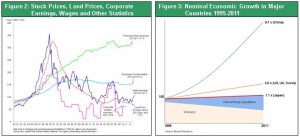
The 1990 shift in the Japan-U.S. security pact
Modern-day Japan experienced its fourth period of transition in 1990. To understand why, we must use a geopolitical perspective that involves the major shift in Japan’s political framework. In 1990, there was a change in the Japan-U.S. security treaty. Until 1990, the treaty functioned as a fortress that protected the entire Far East. Japan stood at the forefront of Asia as an unsinkable aircraft carrier. Japan grew as the nucleus of the U.S. global strategy in political, military and economic terms. Consequently, the treaty no longer had a purpose the instant the Soviet Union and communism worldwide collapsed. But the security agreement has survived most likely because of a major shift in its strategic significance. Early in 1990, the U.S. announced its ‘capping-the-bottle’ stance. Some U.S.officials explained that it spends massive amounts of money to keep troops in Japan for the purpose of holding Japan in check. This does not entail solely preventing another military resurgence and regional expansion of Japan, which was the world’s second-largest economy. Preventing Japan from becoming a military power with nuclear weapons was vital to the U.S. military strategy. Of course, there were still concerns about Far East instability because China, a communist dictatorship, had shown its military might in 1989 at the Tiananmen Square incident. At that time, China was insignificant with regard to the global strategy of the U.S.
Japan’s competitive industries posed the biggest threat to the U.S.: Keep Japan in check
Although the Japan-U.S. alliance has survived, there was a sharp decline in its significance in political and military terms. But there was a complete change with regard to the pact’s economic significance. Talk about the threat posed by Japan’s economy began to emerge in the mid-1980s. In the U.S., there was a growing crisis mentality about declines in the U.S. economy and industrial might is nothing was done about Japan. In fact, U.S. companies were constantly losing to Japanese companies in such key industries as consumer appliances and electronics, semiconductors, computers and automobiles. This problem even started having a significant impact on U.S. jobs. As their financial strength increased, Japanese companies purchased many U.S. firms. Consequently, stopping Japan’s economic growth and preserving U.S. economic leadership became one of the key objectives of the U.S. global strategy.
The U.S. adopted the logic that Japan had an unfair advantage by using factors not linked to capitalism to become more competitive. People believed that Japan relied on an unusual type of capitalism that relies on a strong bureaucracy, business-friendly regulations, corporate groups and affiliations, real estate-based financing and other factors unique to Japan. The result was the ‘Japan is different’ belief. People were convinced of the need to alter these unique characteristics of Japan so that Japanese and U.S. companies could compete on a level playing field. Japan was subjected to enormous pressure. Starting in the late 1980s, Japan’s economic policies were at the mercy of U.S. demands as Japan acceded to almost all U.S. requests.
The capping-the-bottle stance concerning the Japan-U.S. alliance proved to be highly effective at achieving U.S. strategic economic objectives with regard to Japan. However, Japan still had many economic practices from long ago that were in consistent with a market economy but that helped make Japanese companies even more competitive. My conclusion is that the ‘Japan is different’ view is true in many respects from an analytical standpoint. But using these practices to exert pressure on Japan is what enabled the U.S., the world’s only superpower, to achieve its economic goals.
(3) Keeping Japan in check caused deflation by making the yen too strong
Creating an extremely strong yen was the key to holding back Japan
Economic pressure from the U.S. is what produced the 20-year period of stagnation in Japan since 1990 that became known as the ‘Japan disease.’ An unusually strong yen was the decisive element of the process that capped Japan’s economic bottle. Of course, the currency of a country with a massive trade surplus should strengthen in a floating exchange rate system. However, the yen has appreciated to a level that is far too high in relation to its purchasing power. Normally, currencies fluctuate no more than about 30% above or below their purchasing power parities (a measure of a currency’s strength). However, the yen was at one point overvalued to a point that was twice as high as its purchasing power (Figure 5). In other words, Japanese companies were burdened with operating costs that were twice the international standard. High costs forced companies to enact long-term cost-cutting programs. Naturally, wages of Japanese workers were also twice the international standard. Japanese companies responded by cutting workforces, switching from full-time to temporary workers, moving jobs overseas and taking other steps. Labor cost per unit of production plunged as a result and Japanese companies somehow remained competitive. But this was accomplished at the expense of wages. The gradual downturn in wages over many years produced persistent deflation in Japan.
Figure 4 shows the yen-dollar exchange rate and purchasing power parity (the yen’s true strength). In the early 1970s, purchasing power parity was 220 yen but the exchange rate was 360 yen. Japanese companies made goods at a cost of 220 yen and sold them overseas at the 360 yen rate. In the 1990s, the dollar was worth less than 100 yen even though purchasing power parity was 200 yen. No Japanese company could make a profit by making goods at a cost of 200 yen and selling them overseas while receiving only 100 yen for each dollar of sales. There was an enormous negative spread. As long as the yen stays this high, the only way for Japanese companies to prosper was to slash expenses while raising purchasing power parity from 200 yen to 100 yen. Remarkably, Japanese companies accomplished this difficult feat. Unfortunately, Japan has suffered the enormous negative side-effect of deflation as wages fell and unemployment rose.
Figure 4: Purchasing Power Parity and Actual Yen/Dollar Rate
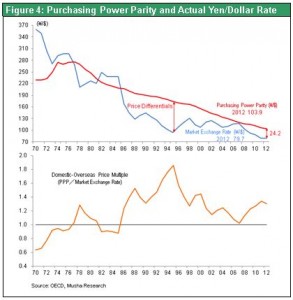
The yen’s strength is not simply an economic phenomenon. There is no doubt that the yen appreciation has also seriously reflected political will too. At the peak of British prosperity in the 19th century during the Victorian Era, the pound was the world’s most powerful currency. British companies used the pound to target business opportunities by purchasing valuable economic resources worldwide. Japan as well should have been able to utilize its huge trade surpluses to increase its clout in the global economy. But Japan was unable to buy valuable resources like U.S. companies and real estate. All Japan did was constantly buy short-term U.S. Treasury securities that carried low interest rates. So this was really a one-sided run-up of the yen.
Since the 2008 outbreak of the global financial crisis, the yen became extremely overvalued (Figure 6) as the currency became the target of speculators who believed in the global deflation scenario. However, I believe this strength is also the result of the ‘built-in’ conviction among investors that the yen will continue to climb simply because the yen has been consistently too high.
Figure 5: Purchasing Power Parity Gaps of Major Currencies
Figure 6: Yen Exchange Rates Since 2007
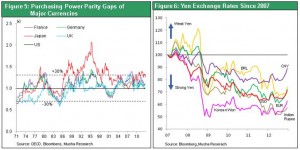
(4) The new geopolitical era of 2010
The emergence of China, a communist autocracy
Since 2010, there has been a growing need to take another look at the Japan-U.S. security treaty. Instead of the ‘Japan is different’ stance of the 1990s, we are now hearing people say that ‘China is different.’ Even more than Japan in the late 1980s, China is now feared because neighboring countries anticipate a destructive level of strength in the near future. China’s GDP ($7.3 trillion in 2011) is about half of the U.S. GDP. At this rate, China’s economy will probably surpass the U.S. economy within 10 years. If nominal economic growth is 5% in the United States and 15% in China, and if there is a 20% increase in the value of the yuan, China’s nominal GDP would be almost the same as the U.S. GDP within about five years. Moreover, as China’s foreign currency reserves continue to increase, its buying power is certain to become far greater than that of any other country. China’s growing global stature is certain to be a disruptive force globally, based on the current status of market-based economies, democracy, the rule of law, financial rights, intellectual property rights that are already problematic issues today. As the world leader, the U.S. cannot allow this to happen. Moreover, even more than Japan, China’s strength depends on a growth structure that relies on overseas technologies, capital and markets. This is why China is enjoying a ‘free lunch’ in many respects.
The Japan-U.S. alliance is vital to exerting pressure on China
Without achieving a balance by enhancing the stature of Japan, China’s neighbor, it will be impossible to contain China and exert pressure on the country to change from within. Enduring prolonged economic stagnation has caused the Japanese public to lose faith in capitalism and a market-based economy. If Japan starts to drift, the result could be widespread instability in East Asia. This explains why revitalizing Japan’s economy has become an urgent matter for the U.S. as the global leader. Richard Armitage, who was former Deputy Secretary of State, Harvard University professor Joseph Nye, and other opinion leaders in discussions about U.S. strategies are extremely concerned about the declining presence of Japan and the danger of Japan becoming a second-class country. The need for economic growth makes it even more unlikely that we will see a reappearance of an unusual upturn in the yen’s value to penalize Japan. As you can see in Figure 7, there has been a steep downturn in Japan’s presence in global finance since 2000. Between the mid-1980s and mid-2000s, Japan enjoyed position as the globe’s sole source of capital surplus. In 2012, Japan will probably have an enormous trade deficit of JPY5 trillion to JPY6 trillion due in part to higher fossil fuel imports following the shutdown of nuclear power plants. Although Japan is maintaining its current account surplus on the back of a positive balance of income, this surplus is smaller than in China, Germany and the major oil-exporting countries. Clearly, we are nearing the end of the age when ‘capping-the-bottle’ measures were required starting in the 1990s to hold down Japan. Ending this period will generate the greatest amount of energy for reversing the extreme appreciation of the yen.
Figure 7: Current Account Surplus vs. Global GDP
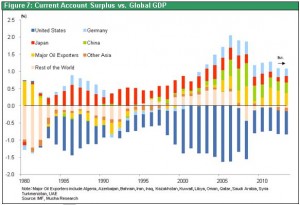
(5) The significance of Abe reflationary measures
Against this backdrop, the reflationary measures of the Abe administration have immense significance. The United States has made steady progress with eliminating the after-effects of the Lehman shock. As a result, credit was restored and economic activity returned to the pre-crisis level. Creative monetary easing measures overseen by Fed Chairman Ben Bernanke probably rescued the United States from the financial crisis. Japan has lagged far behind the steady recoveries that have taken place in the United States and other major countries. Japan alone has suffered from weak stock prices and a strong currency along with the only deflation in the world. From the lowest point after the Lehman Shock, U.S. stock prices have doubled. In Japan, though, stock prices have recovered only 10%, far less than in the United States and Europe where the financial crisis originated. Furthermore, there has been an extreme upturn in the yen in relation to other major currencies. Since the beginning of 2007, the yen appreciated 50% against the Korean won and 30% against the U.S. dollar and euro. The yen’s strength severely eroded the competitive edge of Japanese manufacturers. The backdrop for these events is probably the Bank of Japan’s negative stance regarding monetary easing. But now a major reversal in this stance is finally emerging.
There are two primary causes of the yen’s unusual strength and deflation: (1) U.S. geopolitical demands and (2) the Bank of Japan’s stance of allowing a strong-yen and deflation to continue. Once there is a shift in these two factors, we will see a change in every aspect of how people view investments. Once there is a shift in these two factors, we will see a change in every aspect of how people view investments. Starting in 2013, investors will probably abandon the cash-is-king sentiment and begin to increase their appetite for risk.
Figure 8: Central banks’ Total Assets Ratio to Nominal GDP in Japan, US, Euro and UK after 2007
Figure 9: Equity Indices in Major Countries (2009/3/31=100)
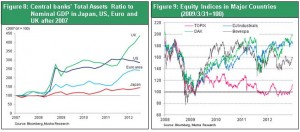


 The yen’s strength is not simply an economic phenomenon. There is no doubt that the yen appreciation has also seriously reflected political will too. At the peak of British prosperity in the 19th century during the Victorian Era, the pound was the world’s most powerful currency. British companies used the pound to target business opportunities by purchasing valuable economic resources worldwide. Japan as well should have been able to utilize its huge trade surpluses to increase its clout in the global economy. But Japan was unable to buy valuable resources like U.S. companies and real estate. All Japan did was constantly buy short-term U.S. Treasury securities that carried low interest rates. So this was really a one-sided run-up of the yen.
Since the 2008 outbreak of the global financial crisis, the yen became extremely overvalued (Figure 6) as the currency became the target of speculators who believed in the global deflation scenario. However, I believe this strength is also the result of the ‘built-in’ conviction among investors that the yen will continue to climb simply because the yen has been consistently too high.
Figure 5: Purchasing Power Parity Gaps of Major Currencies
Figure 6: Yen Exchange Rates Since 2007
The yen’s strength is not simply an economic phenomenon. There is no doubt that the yen appreciation has also seriously reflected political will too. At the peak of British prosperity in the 19th century during the Victorian Era, the pound was the world’s most powerful currency. British companies used the pound to target business opportunities by purchasing valuable economic resources worldwide. Japan as well should have been able to utilize its huge trade surpluses to increase its clout in the global economy. But Japan was unable to buy valuable resources like U.S. companies and real estate. All Japan did was constantly buy short-term U.S. Treasury securities that carried low interest rates. So this was really a one-sided run-up of the yen.
Since the 2008 outbreak of the global financial crisis, the yen became extremely overvalued (Figure 6) as the currency became the target of speculators who believed in the global deflation scenario. However, I believe this strength is also the result of the ‘built-in’ conviction among investors that the yen will continue to climb simply because the yen has been consistently too high.
Figure 5: Purchasing Power Parity Gaps of Major Currencies
Figure 6: Yen Exchange Rates Since 2007




